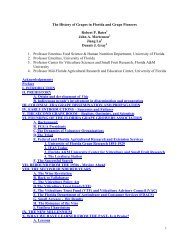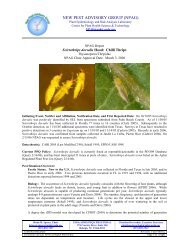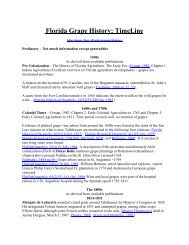'Southern Jewel': A Self-Fertile, Black Muscadine Grape with Fruit ...
'Southern Jewel': A Self-Fertile, Black Muscadine Grape with Fruit ...
'Southern Jewel': A Self-Fertile, Black Muscadine Grape with Fruit ...
Create successful ePaper yourself
Turn your PDF publications into a flip-book with our unique Google optimized e-Paper software.
‘Southern Jewel’: A <strong>Self</strong>-<strong>Fertile</strong>, <strong>Black</strong> <strong>Muscadine</strong> <strong>Grape</strong> <strong>with</strong> <strong>Fruit</strong> Produced on<br />
Bunches has been released by UF/IFAS<br />
Dennis J. Gray, Professor<br />
Mid-Florida Research & Education Center<br />
University of Florida/IFAS<br />
‘Southern Jewel’ is a new muscadine grape cultivar being released by the<br />
University of Florida that is a high-yielding, disease resistant large black-fruited variety.<br />
It has the unique characteristic of producing fruit in bunches of 6 – 12 berries that<br />
strongly adhere to the stem. It has excellent taste and a crunchy texture, <strong>with</strong> a palatable<br />
skin, making it well-suited for fresh fruit consumption.<br />
‘Southern Jewel’ <strong>Muscadine</strong> <strong>Grape</strong>
‘Southern Jewel’ (numbered selection AA11-68) originated from a cross between<br />
‘Granny Val’, a self-fertile, cultivar <strong>with</strong> large (9-10 g) bronze berries and DB3-63, a<br />
self-fertile, black selection <strong>with</strong> large (8-9 g) berries. DB3-63 originated from a cross<br />
between US42-12B, a black self-fertile selection <strong>with</strong> small (3-4 g) berries and ‘Nesbitt’,<br />
a self-fertile black cultivar <strong>with</strong> large (9 g) berries. US42-12B originated from a cross<br />
between ‘Creek’, a reddish black female cultivar <strong>with</strong> small (3 g) berries and a hybrid<br />
between ‘Topsail’, a female, bronze cultivar <strong>with</strong> small (3 g) berries and NCB6-19. The<br />
origin of NC B6-19 is unclear as it was variously described as a sibling of ‘Topsail’<br />
(‘Latham’ x ‘Burgaw’) or a cross between ‘Latham’ and a seedling from ‘Loomis’ x V19<br />
R7 V2.<br />
Pedigree of ‘Southern Jewel’<br />
Berries are oval in shape, becoming reddish, then dark purple/black upon ripening<br />
and 76% have a dry stem scar. <strong>Fruit</strong> ripening date varies seasonally, but tends to occur in<br />
early August at Apopka, approximately 1 to 2 weeks earlier than other muscadine<br />
varieties and one week after ‘Delicious’ which is another early-ripening variety. Early<br />
ripe fruit have a semi-crunchy flesh and an edible skin that fragments easily <strong>with</strong> the<br />
flesh. <strong>Fruit</strong> allowed to ripen further tend to have a softer flesh, become noticeably juicier,<br />
but retain an edible skin. <strong>Fruit</strong> yield is greater, berries are larger and ripen more<br />
uniformly than ‘Alachua’, which also was selected for even-ripening (Table 1). Berry
texture of ‘Southern Jewel’ is more firm than but size is similar to that of ‘Delicious’ and<br />
‘Nesbitt’, however, the latter ripens unevenly and has poorer stem scar characteristics.<br />
‘Southern Home’, a Muscadinia x Euvitis hybrid, has higher soluble solids and ripens<br />
evenly, but ‘Southern Jewel’ exceeds it in all other characteristics. ‘Supreme’, a cultivar<br />
<strong>with</strong> remarkably large berries and excellent fruit characteristics, did not produce an<br />
acceptable yield in this vineyard. It is noteworthy that similar results were obtained <strong>with</strong><br />
‘Supreme’ during previous testing at the Central Florida Research and Education Center<br />
at Leesburg Florida.<br />
Table 1. Flower type, yield and fruit attributes of ‘Southern Jewel’ compared <strong>with</strong> five<br />
black muscadines grown for fresh fruit consumption.<br />
Flower<br />
Cultivar type z<br />
Soluble<br />
<strong>Fruit</strong> <strong>with</strong><br />
solids<br />
Yield/Vine dry scar Berry wt concn Type of<br />
(kg) (%) (g) (%) ripening<br />
Southern<br />
Jewel<br />
S 10.3 76 11.0 15.9 Even<br />
Delicious S 12.9 90 10.2 16.9 Even<br />
Alachua S 9.4 75 7.0 16.8 Even<br />
Nesbitt S 13.1 64 9.9 15.8 Uneven<br />
Southern<br />
S 9.2 58 7.0 18.2 Even<br />
Home<br />
Supreme F 2.3 96 17.8 17.6 Even<br />
z S = self-fertile; F = female, requiring pollinizer.<br />
In taste, texture and edible skin, ‘Southern Jewel’ compares favorably <strong>with</strong><br />
‘Supreme’, however it is earlier ripening and much more productive at Apopka, albeit<br />
smaller in size. Its formation of large berries that adhere to bunches is unique for a<br />
muscadine-type grape and should be useful for both fresh fruit and, possibly, processing.<br />
Although untested, its firm texture and adherence of berry to stem may make it unsuitable
for mechanical harvesting and wine-making. While it grows well on deep sandy soils, it’s<br />
adaptation to other regions has not been confirmed.<br />
‘Southern Jewel’ was publically released by the Cultivar Release Committee of<br />
the Florida Agricultural Experiment Station (FAES), an agricultural research program of<br />
the University of Florida’s Institute of Food and Agricultural Sciences. Inquiries<br />
regarding the availability of ‘Southern Jewel’ should be directed to Florida Foundation<br />
Seed Producers, Inc. P.O. Box 110200, Gainesville, FL 32611-0200. A list of nurseries<br />
selling Florida recommended grape varieties may be obtained from most UF/IFAS<br />
County Extension Offices and the Florida <strong>Grape</strong> Grower’s Association website<br />
(www.fgga.org).






